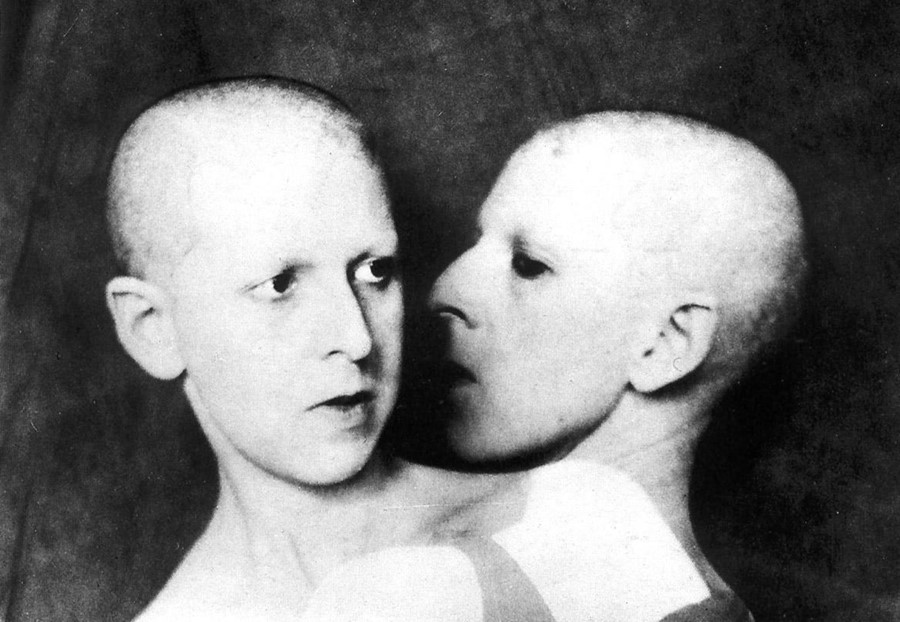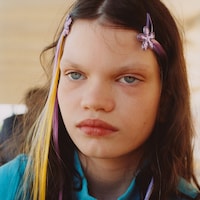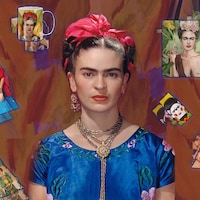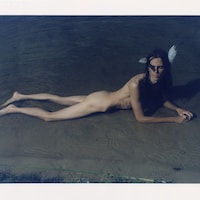Even though history celebrates male surrealists, it was the women who gave the movement its truly conceptual charge
In 1924, French artist André Breton coined the term surrealism in his Manifesto of Surrealism as: “psychic automatism in its pure state, by which one proposes to express – verbally, by means of the written word, or in any other manner – the actual functioning of thought.“ This definition served the movement well, especially because it was inundated with men who were free to think, behave, and express so automatically on their subconscious experiences, dream states, and interior worlds. But for women, who just 30 years earlier were diagnosed by psychoanalyst Sigmund Freud as hysterical for expressing any unusual mental behaviour, the definition of surrealism took on its own critical meaning – it was a way to express the female psyche in a way never done before.
Women emblazoned surrealism with a new type of self-awareness never achieved by their male counterparts. Their intuitive expression turned the movement from something quite dissociated with reality, to a deeply personal exploration of human emotion, personal trauma, the subconscious, female sexuality, and identity, all through a lens of fantasy. Because many female surrealists used to pose as muses for their male counterparts, by reclaiming their role as creators, women were able to dictate how their bodies were represented and thus freed the female body from the oppressive male gaze. Through their work, which was often rampant with sexual desire, the body was restored with power and subjectivity. Overriding the way their mental state was oppressed in the past, surrealism allowed women to express their subconscious freely.
“People talk about surrealism as an art movement, like abstract expressionism or impressionism. Surrealism is a philosophical movement” – Dorothea Tanning
Despite the way in which women brought an entirely new meaning to surrealism, their work has been heavily omitted from history until recent years where many female surrealists have been spotlighted through retrospective exhibitions. In London right now, it’s American surrealist Dorothea Tanning who takes focus at Tate Modern with a retrospective displaying over 100 of the artist’s fantastical paintings, sculptures, and writings from across her 70-year career. As observed through the show, Tanning was key in bringing an unfiltered sexual charge to surrealism and her works enabled her to explore her identity, liberated from social and gendered constructions. “People talk about surrealism as an art movement, like abstract expressionism or impressionism,” Tanning once stated. “Surrealism is a philosophical movement.”
It’s important to note that Tanning was also a keen champion of the idea that women artists should not be canonised by their gender. “Women artists. There’s no such thing – or person,” Tanning once stated. “It’s just as much a contradiction in terms as ‘man artist’ or ‘elephant artist’,” she added. “You may be a woman and you may be an artist, but the one is a given and the other is you.”
Under this same vein, below, we explore how seven artists exceeded their gender constructs to change the entire history of surrealism.
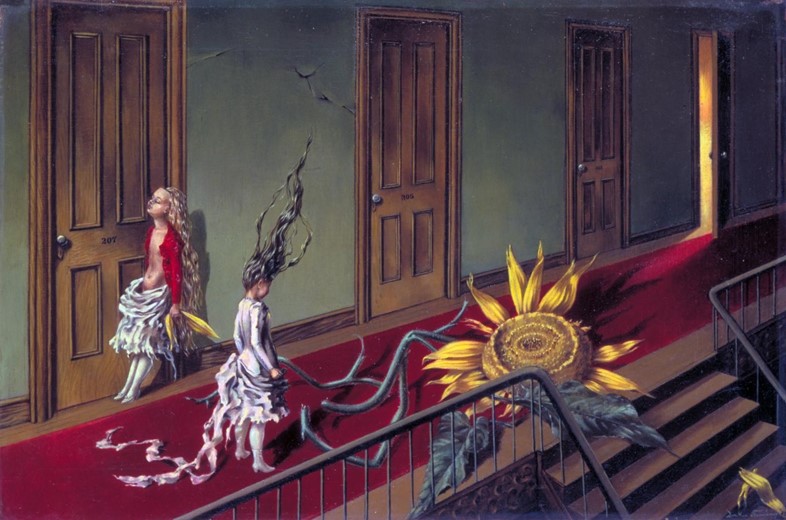
DOROTHEA TANNING
Born in the town of Galesburg, Illinois to Swiss migrant parents in 1910, at age 16, Tanning got a job as an assistant at her local library: a position which would spark her deep passion for creativity, pushing her to move to Chicago and study at the Chicago Academy of Art in 1930. Five years later, Tanning relocated to New York where she worked illustrating ads for Macy’s until she embarked on a career as an artist in the 1940s.
Tanning was introduced to surrealism in 1936 after visiting MoMA’s ground-breaking show Fantastic Art, Dada, Surrealism which included works from Max Ernst, Marcel Duchamp, René Magritte, and more. Astounded with the psychical freedom of the show, she stated in a diaristic reflection in the autobiography Between Lives: An Artist and Her World, “here in the museum is the real explosion, rocking me on my run-over heels. Here is the infinitely faceted world I must have been waiting for. Here is the limitless expanse of POSSIBILITY, a perspective having only incidentally to do with painting on surfaces.”
“Here in the museum is the real explosion, rocking me on my run-over heels. Here is the infinitely faceted world I must have been waiting for” – Dorothea Tanning
In 1942, Tanning painted “Birthday” – a self-portrait that would secure her gateway into surrealism. Rampant with sexual energy, the image shows a raw expression of female sexuality as Tanning stands with flustered hair, an unabashed naked chest, and a wildly ruffled skirt whose materials are reminiscent of tree roots. To the figure’s left is an endless spiral of open doors, and before her a fantastical lemur with wings. The same year “Birthday” was made, surrealist Max Ernst visited Tanning’s home at the instruction of his wife Peggy Guggenheim to go and select a work for her upcoming show Exhibition, 31 Women Artists. Much like the rest of the world that would follow, Ersnt was entranced by “Birthday” and selected it for the show.
In “Birthday”, we find the beginning of the symbolism that would characterise Tanning’s whole career including notions of rebirth, sexuality, and references to Lewis Caroll’s Alice in Wonderland signified in the painting’s never-ending spiral doorway. Alice was one of Tanning’s favourite heroines. By the 1950s, Tanning’s paintings became more abstract and focused on the human form. “I don't see why one shouldn’t be absolutely fascinated with the human form...,” Tanning once stated. “We go through life in this wonderful envelope. Why not acknowledge that and try to say something about it? What I try to say about it is transformation.”
By the 1960s she moved onto making bodily sculptures out of fabric. The artist lived to age 102, and her last creation was a set of poems titled Coming to That which was published at age 101.

MERET OPPENHEIM
When Berlin-born surrealist Meret Oppenheim was a teenager, her psychoanalyst father recommended she write down her dreams – a key practice of surrealist creation and a process that continued throughout the sculptor’s entire career.
At 18, Oppenheim moved to Paris to study at the Académie de la Grande Chaumière, where she soon befriended established surrealists such as Alberto Giacometti and Pablo Picasso. At age 19, she showed her work alongside these artists and modelled nude for Man Ray. By 23, Oppenheim impressively had her first solo show, in which many referred to her as Mr.Oppenheim because of the movement’s embedded masculinity. It is said that Oppenheim convinced these surrealists to join the boys only club – up until her, there were no women allowed.
Oppenheim’s surreality was driven by an awareness of how women were viewed in society in the 1930s, and she used her art as commentary on this experience. Her work was lauded with humorous and erotic tones that were always underlined by a critique of this oppression. To challenge enforced gender roles, Oppenheim commonly incorporated domestic symbolism into across her sculptural works. Take her “Object” (1936) as a prime example.
The sculpture began as a joke over lunch in Paris with fellow surrealists Dora Maar and Pablo Picasso. The duo noticed a fur-lined bracelet Oppenheim was wearing and joked (surrealistically) that anything could be covered with fur. “Even this cup and saucer”, replied Oppenheim. Her imagination flared, and she did exactly that by covering a cup and saucer with brown fur, dismantling the object’s societally intended function. By doing this, Oppenheim subverts the logic and rationality society imposes on domestic objects and the embedded gender structures that come with them. “Object” is now considered one of the most important surrealist objects to date for the way it champions the surrealist idea that when mundane objects are presented in illogical ways, they have the power to challenge reason.
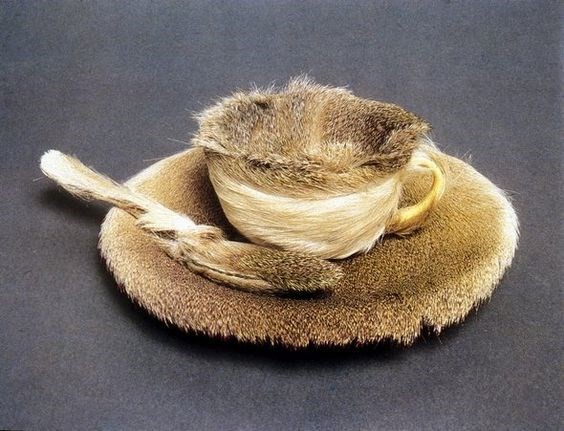
CLAUDE CAHUN
Founding surrealist member Andre Breton once referred to French-Jewish photographer Claude Cahun as “one of the most curious spirits of our time” – and he was right. Cahun’s curiosity came to life in the way she used surrealism to study her own gender identity. With a camera in hand, Cahun fused surrealist tendencies and photography for the ultimate visual study of gender fluidity and the subconscious in the early 1920s. “Under this mask, another mask”, reads one of her most famous quotes. “I will never be finished removing all these faces.”
In 1932, Cahun joined the Association of Revolutionary Writers and Artists in Paris and met Breton shortly after. She then began to align herself more closely with the movement by drafting surrealist texts and exhibiting her photographs with the group. She even penned an open letter in 1934 titled, Les Paris Sont Ouvres (The Parises are Open or Bets are On), that showed her position against formalist and propagandist forms of art as she pledged for love for surrealism.
Cahun’s surrealism is found in the way she subverted the realism of photography by overriding it with uncanny symbolism. One of Cahun’s most commonly used symbols is that of the subconscious ‘double’ where Cahun uncannily appears twice in the same image to explore the fluidity of her identity. Another surrealist approach is in Cahun’s use of photomontage – a key surrealist technique that involves the collaging of symbols. The two sides of her surrealism come together in her collage “Aveux non Avenus” (1930), which was made when Cahun was at the height of her surrealism. The photomontage of surrealist symbolism like eyes, space, and animals, creates a dreamscape world reflective of Cahun’s internal reality. If you look closely, in what appears to be a magnifying glass, we see the reflection of one of her self portraits “Que Me Veux-Tu” (1929) which was a portrait of two Cahuns side by side, made to explore her dual identity and subconscious ‘double’.
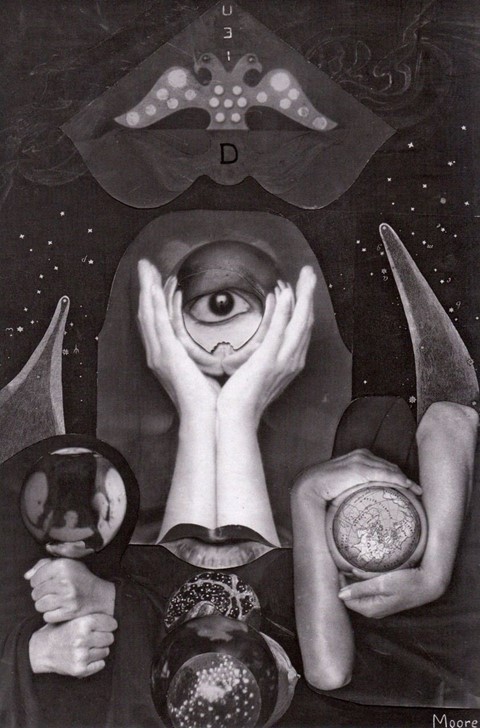
LEONORA FINI
Argentinian painter Leonora Fini was the heroine of surrealist eroticism. She rescued it from the fetishisation of men by painting strong and powerful women (or androgynous characters) who were emblazoned with fetishistic symbols like rubber, corsetry, and tightlacing juxtaposed with mythical figures like sphinxes, werewolves, and witches. Her works, which were often drawn from sexual experimentation and rebellion, showed how sexual subversiveness was a source of great power.
While other surrealists were driven by automatic thinking and creating, Fini was driven by uninhabited sexual desire. She commonly role-played by using masks, men’s clothes, and was one of the only women to create work from the writings of 19th-century fetishist, the Marquis de Sade (from which the word sadomasochism comes from). With an entire reality embedded in sexual liberty, this direct evocation translates through works like Fini’s “Femme en Armue II” (1938) which features outlaw French writer Jean Genet as a woman tight-laced in a rubber corset and gloves. The finite detail in which Fini visualises the rubber, and the way in which they act as armour for an outlawed creative show Fini’s affination with sex as a form of saviour.
Her influence on surrealism is also seen in the way she recontextualised the male surrealist canon through her work. While masculinity was prided through the work of male surrealists as strong and powerful, Fini makes men her submissives by painting them in passive, sleep like states, often at the call of her heroine women. We see this in her 1942 painting “Woman Seated on a Naked Man”.

LEE MILLER
American photographer Lee Miller revolutionised surrealist photography, especially its relation to fashion. Starting her career as a model in New York for Vogue in the 1920s, she then moved to Paris where she pursued fashion and fine art photography.
While in Paris, Miller met Man Ray and soon became his apprentice, lover, and muse, while running in surrealist circles with the likes of artists Picasso and Jean Cocteau. It was here that she started her own photo studio, often taking on Ray’s assignments to the point where many of the photos taken in the 1930s that were credited to Ray were actually taken by Miller. But while history would commonly label Miller as a muse before an artist, Miller was always an inherent surrealist in her own merit.
The psychological depth and emotional freedom of Miller’s works was a direct correlation of her bohemian lifestyle, which liberated her from what was expected of her as a woman in the 1930s-40s. She worked, owned her own studio, travelled freely, and was even a war photography correspondent for British Vogue. She projected her surrealist vision onto everything she did, particularly that of her fashion photography where she juxtaposed traditional fashion symbolism with unexpected scenery and settings to dismantle rationality, especially when such irrationality was needed to understand the turbulence of her times in the first and second world wars.
Miller’s surreal influence on Ray seeps through images like Miller’s 1930 “Nude Bent Forward”. The duo share style in black and white minimalism, but unlike Ray’s images which tend to eroticise the female form, Miller’s eye sets the body free – her nudes are an important reclamation of the female body from the fetishisation and objectification of the male gaze.
Beyond nudes, Miller’s surrealism travels through her work as Vogue’s World War II photo correspondent where she blended photo-reportage and surrealism to create provocative images. “Her photographs shocked people out of their comfort zone,” once said Mark Haworth-Booth, curator of V&A’s 2007 show The Art of Lee Miller, to the New York Times. “She had a chip of ice in her heart. She got very close to things… That’s what makes the difference – Lee was prepared to shock.”
LEONORA CARRINGTON
English surrealist Leonora Carrington’s most important influence on the movement was how she redefined its symbolism by drawing on her childhood of growing up on a farm, and the Celtic folklore fairy tales that her Irish Nanny used to read to her. Her celestial, dreamlike works incorporate her childhood memories alongside references to psychoanalyst Carl Jung, medieval alchemy, and Renaissance paintings.
Rather than the passive object that women became in male surrealism, the women Carrington painted were brave, strong, and enshrined in mythical status as she painted from her real-life friendships and relationships with women. She also often painted figures as half-animal, half-human to explore humanity’s link to the natural world. Her 1938 “Self Portrait” features Carrington seated in a room surrounded by mythical looking horses. Wearing trousers, Carrington’s position in the image is a symbol of rebellion against gendered norms of the era which saw it only appropriate for women to wear dresses and skirts. The horse was seen in surrealism, especially used by Salvador Dalí, as a symbol of aggressive hedonism, unconscious desire, and sexual potential. The horse was a symbol throughout Carrington’s oeuvre, including her 1954 painting “El Juglar”, one of her most renowned works, that features a circus-like a dreamscape of horses, personal references, and mythical creatures.
While in Paris in the 1930s, Carrington befriended fellow surrealist Remedios Varo and their friendship became an everlasting symbol of the power of female unity in the face of surrealism’s embedded misogyny. In the 1940s, the duo escaped the aftermath of World War II by relocating to Mexico where they spent their time mischievously creating elaborate parties with fantastical costumes, concocting alchemical recipes, painting, and writing. As outsiders ostracised from the Mexican art scene, the duo’s unity was key to their survival and creative expression.
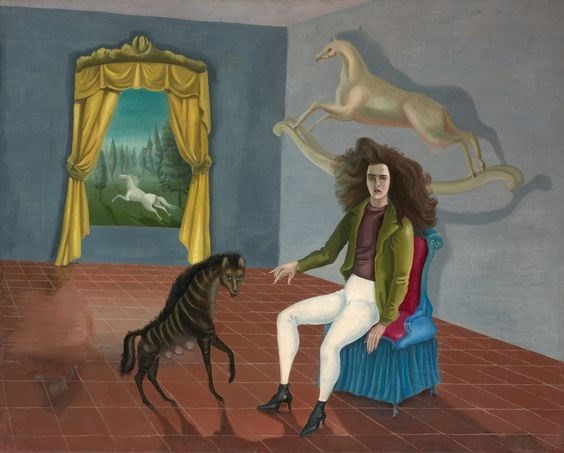
DORA MAAR
Because of art history’s gendered canon, Dora Maar is most commonly known as Picasso’s ‘dark muse’ for being the subject of many of his paintings and his mistress for 10 years. What history fails to acknowledge, however, is that Maar is one of the most influential photographers of the surrealist movement for the way she mastered her interior vision. With her camera and unique ability to use surrealist symbolism, Maar rendered her subconscious world with utter surreality.
Maar employed symbols in her images common to the movement like shells, spirals, hair and shadows but always with dark undertones that alluded to the uncanny state of the human subconscious. Her 1936 photograph “Pere Ubu” was imbued with so much surrealism that it became the emblem for the movement after it was shown at London’s International Surrealist Exhibition in the same year. She was one of the only female contributors, alongside Dali, Magritte, Ernst and more.
Maar was also a master of photo-montage which saw her place everyday mundane objects in expected settings. For example, one of her first photomontages, “Untitled” (1934), centres a human hand that appears to be crawling out of a shell, in front of a backdrop of the sky as if the image was taken from space. Hands were a key symbol of the surrealist movement for the way they represent human connection to flesh, fetishes, pain, and pleasure and the automatism that comes with feeling these experiences. Photomontages aside, Maar also documented the surrealist movement by taking portraits of the artists that surrounded her.

Dorothea Tanning is running at Tate Modern until 9 June 2019. You can find out more here
